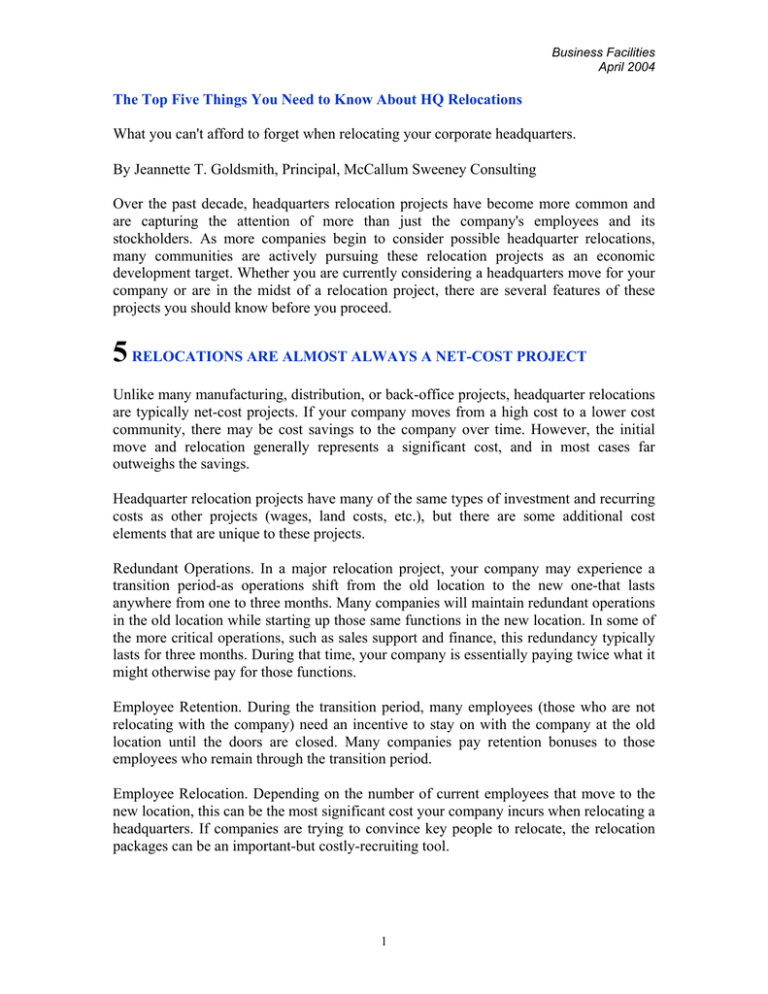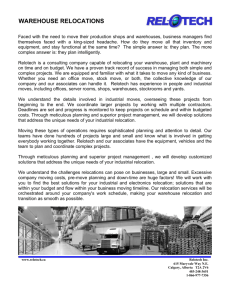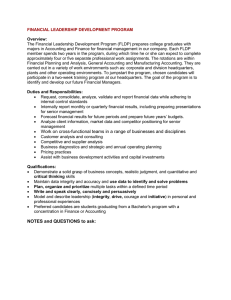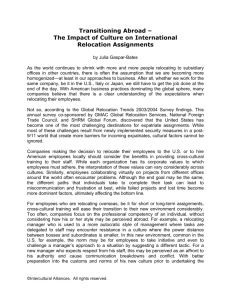The Top Five Things You Need to Know About HQ... What you can't afford to forget when relocating your corporate... By Jeannette T. Goldsmith, Principal, McCallum Sweeney Consulting
advertisement

Business Facilities April 2004 The Top Five Things You Need to Know About HQ Relocations What you can't afford to forget when relocating your corporate headquarters. By Jeannette T. Goldsmith, Principal, McCallum Sweeney Consulting Over the past decade, headquarters relocation projects have become more common and are capturing the attention of more than just the company's employees and its stockholders. As more companies begin to consider possible headquarter relocations, many communities are actively pursuing these relocation projects as an economic development target. Whether you are currently considering a headquarters move for your company or are in the midst of a relocation project, there are several features of these projects you should know before you proceed. 5 RELOCATIONS ARE ALMOST ALWAYS A NET-COST PROJECT Unlike many manufacturing, distribution, or back-office projects, headquarter relocations are typically net-cost projects. If your company moves from a high cost to a lower cost community, there may be cost savings to the company over time. However, the initial move and relocation generally represents a significant cost, and in most cases far outweighs the savings. Headquarter relocation projects have many of the same types of investment and recurring costs as other projects (wages, land costs, etc.), but there are some additional cost elements that are unique to these projects. Redundant Operations. In a major relocation project, your company may experience a transition period-as operations shift from the old location to the new one-that lasts anywhere from one to three months. Many companies will maintain redundant operations in the old location while starting up those same functions in the new location. In some of the more critical operations, such as sales support and finance, this redundancy typically lasts for three months. During that time, your company is essentially paying twice what it might otherwise pay for those functions. Employee Retention. During the transition period, many employees (those who are not relocating with the company) need an incentive to stay on with the company at the old location until the doors are closed. Many companies pay retention bonuses to those employees who remain through the transition period. Employee Relocation. Depending on the number of current employees that move to the new location, this can be the most significant cost your company incurs when relocating a headquarters. If companies are trying to convince key people to relocate, the relocation packages can be an important-but costly-recruiting tool. 1 Business Facilities April 2004 Property disposal. This would include any and all costs of carrying and disposing of the property in the old location. The overall costs of property disposal depends on the location of the existing facility (is it in a high cost location?), the size of the facility, and its age. Employee Severance. For those employees who choose not to move to the new location, companies will often pay a severance. Again, the overall cost of employee severance depends on the number of people who are not relocating, but it is almost always an additional major cost item. 4 CHOOSE INCENTIVES THAT OFFSET MAJOR COST ITEMS As with all capital investment decisions, incentives do not drive headquarter relocation projects. Given that the final location choice tends to be more subjective, however, incentives can make a significant impact on your final decision. In addition, up-front incentives will be important to headquarter relocation projects because of the net-cost issue discussed above. Given the unique nature of the costs that are incurred during a headquarters relocation project, it is important that your chosen community offers incentives that mitigate some of your critical costs. In addition to traditional financial incentives (bonds, tax abatements, etc.), many communities are also offer assistance to help your with specific relocation costs. Community assistance can come in the form of grants offered to offset transition or relocation costs. Even if a community cannot offer cash grants, there are other ways to assist in the relocation process. This type of assistance most often involves the organization of trips to the new location that will introduce your employees to the community. Similarly, an ideal headquarters location will offer the incentive of organizing local service providers (such as real estate companies, banks, attorneys, etc.) and offering discounts to your company's relocating employees for certain services. 3 UNDERSTAND WHY YOUR COMPANY IS UNDERTAKING A MOVE IN THE FIRST PLACE If you are in the midst of moving your company's headquarters, it is vitally important that you understand the reason your company is considering the move. There are many reasons companies consider relocating their corporate headquarters. Among the more common reasons are: A desire to be closer to existing operations or markets. Many companies are moving to be in closer proximity to their customers or markets, which may have shifted over time. Similarly, as older manufacturing facilities are closed and newer ones opened, companies 2 Business Facilities April 2004 may move their headquarters to be closer to those new manufacturing operations. The need to be closer to financial markets is another potential reason for headquarter moves. Image. As a company transforms itself to meet new demand or take advantage of new opportunities, it often also has a need to project a new image in the marketplace. And as the company's image changes, it may find that its existing home no longer fits this new image. This was certainly true for The Boeing Company in its relocation to Chicago in 2001. As Boeing's business became a more even split between commercial aviation and defense work, it found a need to distance itself physically from its commercial airplane business based in Puget Sound. That spurred the decision to look for a new home for the company's headquarters. The image or reputation of a community is an equally important element in the corporate headquarters relocation decision. For certain types of businesses it is critical to be in certain cities. For example, financial services company would be remiss if they did not at least have a presence in New York City. This is true in other sectors as well. Recently, Caremark Rx Inc. moved its headquarters from Birmingham, AL to Nashville, TN. One of the oft-quoted reasons for this move is the fact that Nashville is widely regarded as being a center of excellence in the health care industry. Costs. This is, of course, a very common reason for relocating a company's corporate headquarters, and a very important aspect of these projects as well (for a full discussion, see #1 below). Many companies have spent the past couple of decades wringing every last penny out of their manufacturing and business processes. With that accomplished, companies are looking to their corporate and regional headquarter operations for way to realize even more cost savings. Also, many corporations are looking at the possibility of moving to lower cost locations to help reduce their overall costs of doing business. Mergers and Acquisitions. Perhaps the most common reason for corporate relocations is merger and acquisition activity. The merger of two companies results in duplicate services, often in two different locations. In those instances, the company is faced with a decision of consolidating in one of its existing locations or moving to a new location altogether. The decision to abandon two existing locations for a new one is often times driven by the desire to create a brand new image for the new company. 2 UNDERSTAND THE RISKS While there is a significant amount of risk involved in every capital investment decision, the risks for headquarters relocations are distinctive, and they can be very costly. There are two critical risk concerns. First, for commodity-oriented companies, there is a sales risk. There is always the possibility for disruption in your company's sales cycles while your company is in the midst of a move. In today's highly competitive economy, that disruption could result in lower revenues or earnings or a loss in market share. 3 Business Facilities April 2004 Second, there is a risk that some key employees may not want to relocate. For companies (or specific functions within companies like product design) at which where the people are the most important asset, this risk can be a frightening proposition. This, more than other issue, is the primary reason most headquarter relocation projects never get off the ground. 1 THE CRITICAL FACTORS ARE DIFFERENT Like all new facility projects, there are some factors in the headquarter location decision process that are more important than others. Compared to manufacturing, distribution, or other office projects, the critical success factors for headquarter projects are different, and those differences are important. Some of these factors include: Legal Climate. Although not often discussed, an important issue for corporate headquarters is the legal environment of the new community. This is particularly important to manufacturers who are looking to be in locations where tort reform of some sort has been enacted and juries are known to be less extreme in their awards. Recently, the United States Chamber of Commerce Institute for Legal Reform released its annual State Liability Systems Ranking Study, which ranks the states in terms of their legal fairness. Find out where your state ranks and understand how this might impact the location of a potential headquarters operation. Air Transportation. For most corporate headquarters, access to quality air transportation is critical. The ability to get to most major cities as well as cities where your company has other operations with just one flight is critical. This generally means you'll be looking for locations with a hub airport. In addition, the frequency of flights to key destinations is important, as are the ease of access to the airport and the on-time record of the airport. Finally, for international headquarters or companies with international operations, an airport that offers flights to international destinations is critically important. Quality of life. For most facility decisions, quality of life is a factor that is usually considered to be important, but of less concern than a factor like cost. For headquarter relocation projects, quality of life is often the project's primary driver and likewise the most important factor. If you're currently located in a community where the quality of life does not enhance, but rather hinders employee productivity, you should look closely at this factor. Examine statistics such as the access to quality housing, crime rate, commute times, education, availability of day care, and access to health care when evaluating potential new communities. In addition, quality of life will be an important issue if you plan on relocating a significant number of employees. Labor Availability. While most companies that relocate their corporate headquarters will try to also relocate their existing workforce, the availability of a qualified labor pool for current and future vacancies should remain an important determining factor. Communities that are growing and have an influx of new residents will have an advantage for companies that are seeking to grow their business in that community. For 4 Business Facilities April 2004 example, USAA Insurance opened a regional headquarters in Phoenix, AZ primarily because the community could continue to provide and sustain a workforce of 15,000 employees. Costs. Cost of doing business is one of the most critical factors of any capital investment decision, and it certainly should play a role in your headquarter relocation project. As mentioned above, many companies are looking for locations that will provide cost savings in their headquarter operations, either through lower building costs or lease rates, lower tax burdens, or lower initial salary rates for local hires. Equally important to these projects is the cost of living. Many headquarter moves out of higher cost cities are driven by the high cost of living-primarily housing costs-in that community. SOURCES USED FOR THIS ARTICLE Caremark Rx to move HQ to Nashville. Nashville Business Journal, May 27, 2003. State Liability Systems Ranking Study. United States Chamber of Commerce Institute for Legal Reform (www.legal reformnow.com). Jeannette T. Goldsmith is a Principal with McCallum Sweeney Consulting (MSC) in Greenville, SC (www.mccallumsweeney .com). MSC provides site selection, incentive negotiation, and economic development services to firms and agencies worldwide. 5





